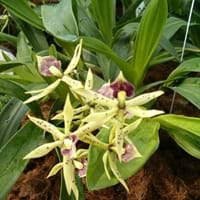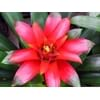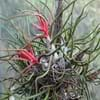Life Span
Perennial
Perennial
Origin
Southeastern United States, South-Central United States, Mexico, Caribbean, Central America, South America, Argentina
Southeastern United States, Latin America and the Caribbean, Caribbean, Central America, South America
Types
Bigleaf hydrangea, Hortensia, Smooth hydrangea, Oakleaf hydrangea, Annabelle
Not Available
Number of Varieties
Not Available
Habitat
Forest edges, Hillside, Woods
Swamps
USDA Hardiness Zone
8-15
10-13
Sunset Zone
H1, H2, 18, 19, 20, 21, 22, 23, 24
H1, H2, 23, 24
Habit
Prostrate/Trailing
Clump-Forming
Minimum Height
Not Available
Minimum Width
Not Available
Flower Color
Yellow green, Chartreuse
White, Burgundy, Dark Red, Light Green, Violet, Dark Salmon
Flower Color Modifier
Not Available
Multi-Color
Fruit Color
Not Available
Not Available
Leaf Color in Spring
Gray Green, Silver
Green
Leaf Color in Summer
Light Green, Gray Green, Silver
Green
Leaf Color in Fall
Light Green, Gray Green, Silver
Green
Leaf Color in Winter
Gray Green, Silver, Gray
Green
Leaf Shape
Oblovate
Long Linear
Plant Season
Spring, Summer, Fall, Winter
Spring, Summer, Fall
Sunlight
Partial Sun, Partial shade
Partial Sun, Partial shade
Type of Soil
Not Available
Not Available
The pH of Soil
Not Available
Neutral, Slightly Acidic
Soil Drainage
Not Available
Well drained
Bloom Time
Early Summer, Summer
Late Spring, Early Summer, Summer, Late Summer, Early Fall, Fall, Late Fall
Tolerances
Not Available
Not Available
Where to Plant?
Container, Ground
Container, Ground, Pot
How to Plant?
Seedlings, Stem Planting
Bulbs, By dividing rhizomes, tubers, Divison
Plant Maintenance
Medium
Medium
Watering Requirements
Not Available
Average Water Needs, Do Not over Water, Requires regular watering
In Summer
Drought Tolerant, Average Water
Lots of watering
In Spring
Moderate
Moderate
In Winter
Average Water
Average Water
Soil pH
Not Available
Neutral, Slightly Acidic
Soil Type
Not Available
Not Available
Soil Drainage Capacity
Not Available
Well drained
Sun Exposure
Partial Sun, Partial shade
Partial Sun, Partial shade
Pruning
Remove damaged leaves, Remove dead branches, Remove dead leaves
Remove damaged leaves, Remove dead branches, Remove dead leaves
Fertilizers
All-Purpose Liquid Fertilizer
All-Purpose Liquid Fertilizer
Pests and Diseases
Red blotch
Red blotch
Plant Tolerance
Not Available
Drought
Flower Petal Number
Single
Single
Foliage Texture
Fine
Coarse
Foliage Sheen
Matte
Glossy
Attracts
Not Available
Bees, pollinators
Allergy
Chest tightness, Diarrhea, Dizziness, Nausea, Vomiting
no allergic reactions
Aesthetic Uses
Not Available
Bouquets, Showy Purposes
Beauty Benefits
Not Available
Not Available
Edible Uses
Not Available
No
Environmental Uses
Air purification
Air purification
Medicinal Uses
Fever, Kidney problems, Urinary tract problems
Cancer, Eye Problems
Part of Plant Used
Flowers, Root
Bulbs, Flowers, Leaves
Other Uses
Not Available
Used as Ornamental plant
Used As Indoor Plant
Not Available
Yes
Used As Outdoor Plant
Yes
Yes
Garden Design
Dried Flower/Everlasting, Hanging Basket, Tropical
Container, Feature Plant, Houseplant, Mixed Border
Botanical Name
TILLANDSIA usneoides
PROSTHECHEA cochleata
Common Name
Graybeard, Spanish Moss
Clamshell Orchid, Cockleshell Orchid, Black Orchid
In Hindi
Hydrangea
Clamshell Orchid
In German
Hortensie
Clamshell Orchid
In French
Hortensia
Clamshell Orchid
In Spanish
Hortensia
Clamshell Orchid
In Greek
υδραγεία
Encyclia Cochleata
In Portuguese
Hortênsia
Clamshell Orchid
In Polish
Hortensja
Clamshell Orchid
In Latin
Hibiscus
Clamshell Orchid
Phylum
Not Available
Magnoliophyta
Class
Not Available
Liliopsida
Order
Not Available
Orchidales
Family
Bromeliaceae
Orchidaceae
Genus
Not Available
Prosthechea
Clade
Not Available
Angiosperms, Monocots
Tribe
Not Available
Epidendreae
Subfamily
Not Available
Epidendroideae
Number of Species
Not Available
Not Available
Importance of Spanish Moss and Clamshell Orchid
Want to have the most appropriate plant for your garden? You might want to know the importance of Spanish Moss and Clamshell Orchid. Basically, these two plants vary in many aspects. Compare Spanish Moss and Clamshell Orchid as they differ in many characteristics such as their life, care, benefits, facts, etc. Every gardener must at least have the slightest clue about the plants he wants to plant in his garden. Compare their benefits, which differ in many ways like facts and uses. The medicinal use of Spanish Moss is Fever, Kidney problems and Urinary tract problems whereas of Clamshell Orchid is Cancer and Eye Problems. Spanish Moss has beauty benefits as follows: Not Available while Clamshell Orchid has beauty benefits as follows: Not Available.
Compare Facts of Spanish Moss vs Clamshell Orchid
How to choose the best garden plant for your garden depending upon its facts? Here garden plant comparison will help you to solve this query. Compare the facts of Spanish Moss vs Clamshell Orchid and know which one to choose. As garden plants have benefits and other uses, allergy is also a major drawback of plants for some people. Allergic reactions of Spanish Moss are Chest tightness, Diarrhea, Dizziness, Nausea and Vomiting whereas of Clamshell Orchid have no allergic reactions respectively. Having a fruit bearing plant in your garden can be a plus point of your garden. Spanish Moss has no showy fruits and Clamshell Orchid has no showy fruits. Also Spanish Moss is not flowering and Clamshell Orchid is not flowering . You can compare Spanish Moss and Clamshell Orchid facts and facts of other plants too.




